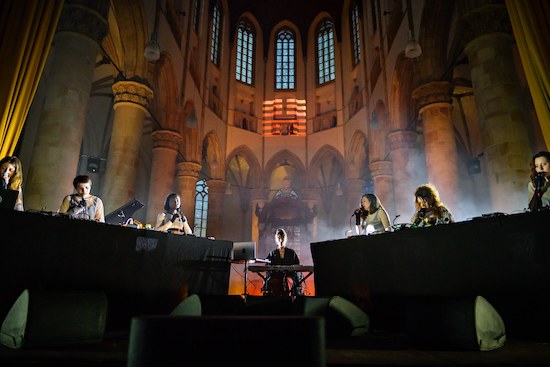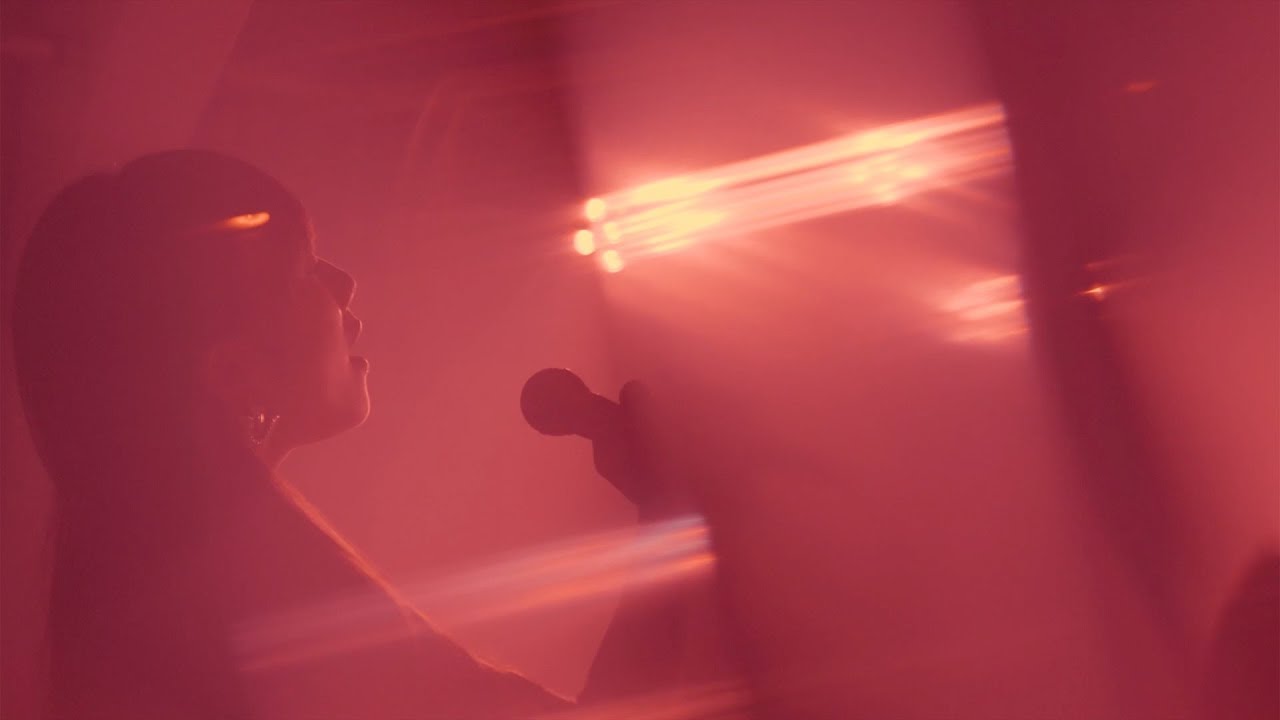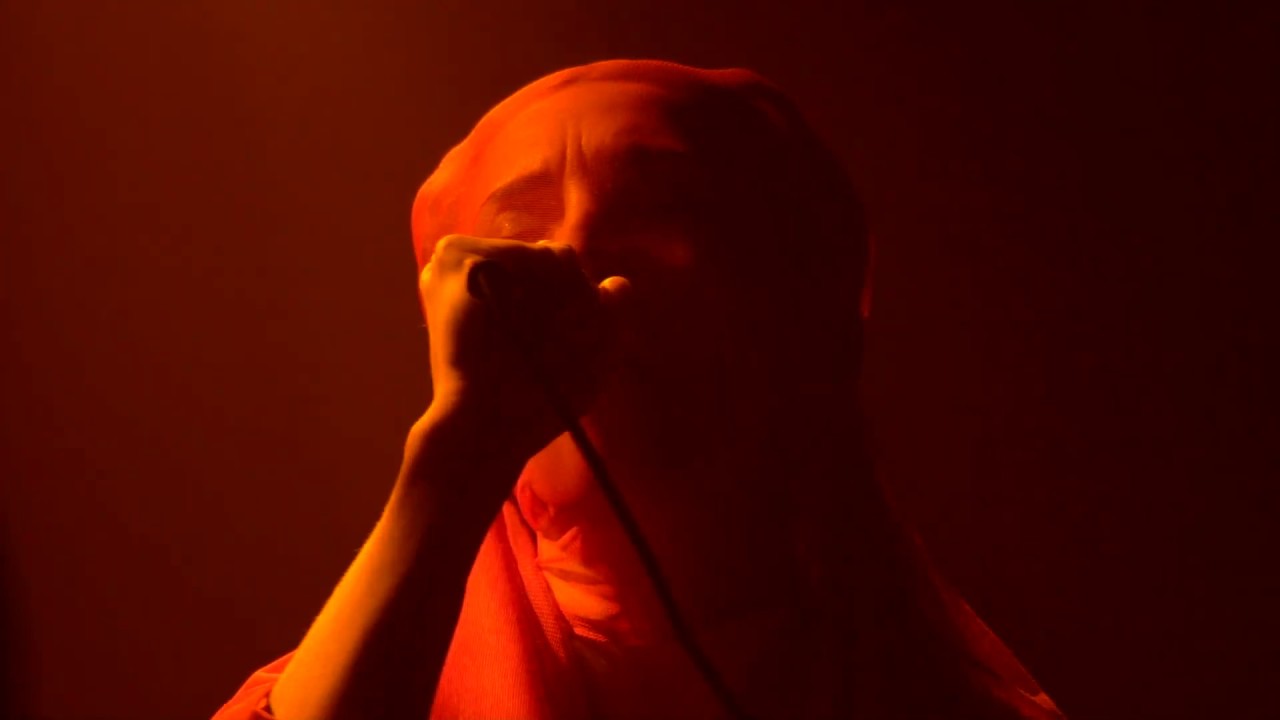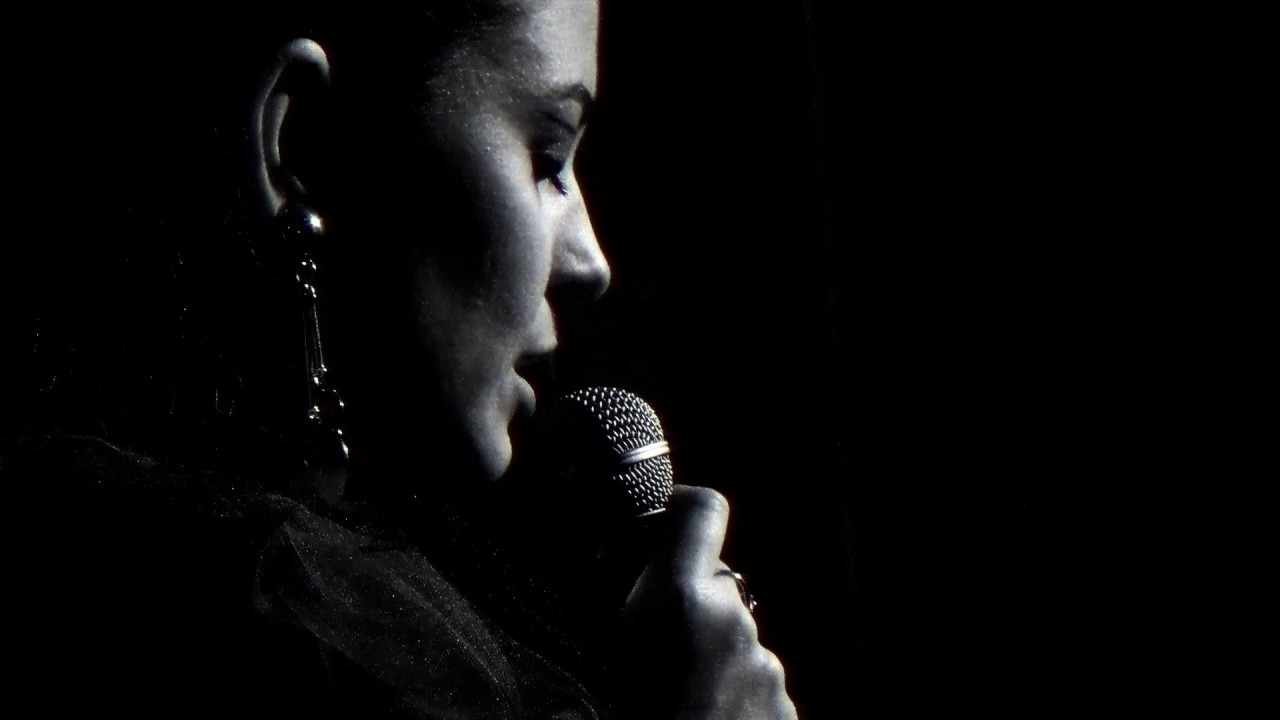The NYX all-female electronic choir create euphoric and immersive experiences for audiences using noise and drone. After an opening season working with Hatis Noit, Gazelle Twin, Iona Fortune and Alicia Jane Turner, and international premiere at Rewire Festival, here are their collected stories for a pluri-vocal take on a vibrant, and vibrational, creative process.
"Singing together can uplift and give space to the vulnerable parts of ourselves" – (Sian O Gorman, NYX Musical Director)
I sat down for the first time with Sian and Philippa (Neels, NYX co-creator) on a kerbside in a residential street in New Cross, on a sticky afternoon in the early part of summer 2018. We’d been to a House of Covens gig at the hARTSlane project space and a general discussion of witchy music gave way to an outpouring on a new choir project they were developing, an all-female electronic choir. At that point an as yet unwoven tapestry of interests and aspirations emerged ranging from psychoacoustics and sound healing, the power of collective experience, voices and electronics, female spaces of making, and the bodily experience of noise and maximal music. By the time the considerably more familiar chill of October had arrived NYX’s inaugural ‘Series 1’ had begun – four performance events spanning October 2018 to March 2019 structured as four collaborations with established solo artists Hatis Noit, Gazelle Twin, Iona Fortune and Alicia Jane Turner. I’ve spent from then until now attending rehearsals and gigs, speaking to the choir and their wider circle of collaborators, to unpick and re-entangle the threads of this project.
like water
The limits or boundaries of the choir are rather like a set of shifting co-ordinates. Describing themselves as "a collective working in open rotation" the choir is as much constituted by its collaborating guest artists and creative producers as the singing chorus itself. Sian explains, "The goal is to have a wide community that comes together and jams on a more casual basis – to experiment, connect and develop technical skills – and from that wider group a smaller group is determined on a project-by-project basis."
The singers themselves have a range of experiences in vocal work. Some like Cecilia Forssberg come from a predominantly choral background, Ruth Corey is an active session vocalist alongside her solo project Daughter of the World, and Kelechi Anucha rediscovered her voice in her mid twenties after workshopping with Lips Choir, and has been part of Nawi black women and femmes vocal collective and avant orchestra He Was Eaten by Owls. For others, like Shireen Querishi from a visual arts background, this is the first time she’s used her voice in a performance context.
The NYX sound is a product of their eclecticism. Sian speaks candidly about her classical background having a simultaneously positive and negative impact on her development as a vocalist, and her subsequent need to embrace different worldviews, techniques and traditions to enable her to continue to sing. Many of the choir members echo her sentiments, Kelechi explains, "I was drawn to NYX as space to really push the boundaries of singing beyond what is "pretty" or even comfortable to listen to, and its opportunities for people with less conventional vocal ranges or training."
In NYX, you hear the bel canto operatic training, but also the recognisable close harmony of the Bulgarian folk choir tradition, or use of chanting and mantra; its no surprise that the choir’s cited influences include Meredith Monk and Lisa Gerrard [Dead Can Dance] as contemporary vocal pioneers, but there is as much drawn from Kate Bush and Diamanda Galas to these ears. Some extended techniques we hear somehow deny a categorisation to any specific tradition, perhaps because they are so ubiquitous, so prosaic yet equally cast out, ones we don’t vocalise so often beyond childhood – whispering, shrieking and other chirrups, pops and squeals… this is the territory of NYX, their own idioglossia. These are some failed attempts at gig notes on vocal utterances heard, Hatis Noit with NYX at The Pickle Factory, in October 2018:
high pitches chattering, firework vocals
small fragments of song and spoken narrative revolve in gradually disintegrating field recordings
whistling, blowing into mics, hushing and shushing
a disarmingly mangled and pitch shifted vocal leads a call and response with the others
shattered shards of whispers make it through a gate somehow
bold cries and calls drawn up from deep in the belly
They inhabit an ambiguous position, bridging a gap between choirs from a folk or classical tradition, and bands in a popular music landscape. They have their own material, but consciously submerge themselves in the material of others, and the membrane between the two is very fine. Imogen Knight, movement director working with[in] the collective, suggests this liminality is something she’s keen to protect and foster as it affords them an open creative process and identity; the possibility to circumvent preconceived expectations or marketing considerations. "I kind of love the fact it never gets too known, too over rehearsed, too clearly hewn – they can be like water".
on ritual
References to embodiment and the transcendental come up frequently in my time with the choir. Hatis Noit described her performance preparation as feeling "the deep statement of my body, its energy, to be very calm, almost nothing. It’s not an emotional thing, its below emotional." Gazelle Twin spoke passionately about her early musical ambitions, "to create something transformative to the listener; emotionally, spiritually, and even physically. The music I consumed most obsessively from my mid-teens was choral music – whether religious or not, early or contemporary – it seemed to enable me to transcend to another place, a place of infinite space, complete respite, a kind of freedom of the mind from the body."
The choir utilise guided meditation and collective visualisation as rehearsal and improvisation tools, and have explicitly stated their performances are a space of healing for themselves and audiences, in a recent article on music and mental wellbeing. Curatorial decisions set the scene for intimate experiences, "Early Sunday evening shows, open spaces, blankets, comfy seating and supporting acts including spoken word artist Belinda Zhawi, DJ Anna Wall, Flora Yin Wong and Lafawndah have helped us build an audience that is receptive to deep listening," says Josh Thomas, NYX co-creator.
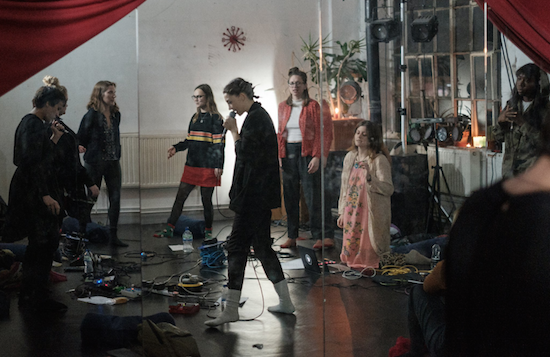
Combined with musical techniques of repetition and drone, the framework of a choir, and the history and presence of these sonic markers across many religious and spiritual rites and practices, there is a danger that my framing of the idea of ritual in their work will become something reductive, on a single plane. So I’m going to tackle the spectre of ritual that looms large here from some different perspectives.
There are rituals enacted or established here in the spaces of what I’m going to call collective learning, collective performing and collective dreaming. Any musician will tell you that being in a band first requires learning how to be in a band, and sure you learn a lot about all sorts of things from that experience. But here, creating a site of mutually supportive learning for its members seems to be at the core of the collective agenda. Philippa explains that, "we want to create safe spaces that give artists permission to take risks, and to give each choir member the agency to improvise and react within a performance." So rehearsals are sites of improvising, co-authoring, and just "working it out" openly and together, and complimenting this is an active training programme (across Series 1 in subjects as diverse as overtone singing with Candida Valentino and using performance software with Ableton.) What’s generated is NYX but also feeds members’ own practices, Shireen tells me these experiences "are like being give a key to something you always wanted to unlock." The collaborating solo artists also seemed struck by the impact of shared spaces of making. Iona Fortune reflects, "having never collaborated before I was a bit of a fox walking over sheet ice, wary of cracks, but when Sian sent over the first demo I knew that ice was rock solid." Hatis Noit told me, "Just before going onstage in the backstage area we all touched each other like here or here [points to her collar bone, then upper back] and encouraged each other for the stage. I never had that experience before my show because I am just by myself, so I need to be strong alone. But working with them, we were taking care of each other."
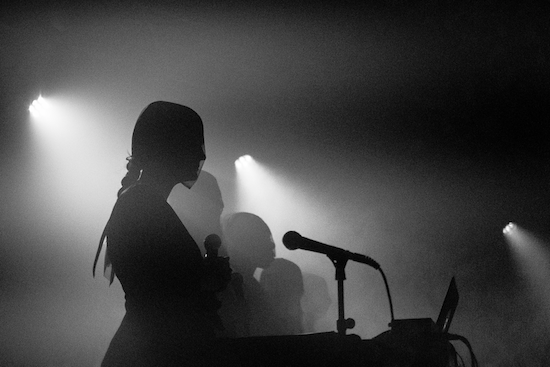
Finally, Imogen suggests that the transparent visual staging of NYX with its heightened awareness of the technology in use, "creates a ritual that does not feel overly choreographed, or like you should know something that you don’t and not in a good way." Philippa adds that, "I think experimental art can be inclusive, and for us that involves physically deconstructing compositions and putting the pieces back together in front of our audience." By engaging in an active demystification of what is, let’s be clear, a complex technical set up with ten voices each engaged in individual electronic manipulation, we have a performative "giving." But in the context of an all female choir and what Alicia Jane Turner highlights as a societal tendency to "tether masculinity to technology", it is clear this is a giving but not a submitting.
"They can stand there and just be. I’m really into not smiling," says Imogen Knight, "and not to look like an arsehole or anything, but just to be aware that women are always encouraged to smile onstage, especially singers. And then at the end be very bashful. Just saying no to that."
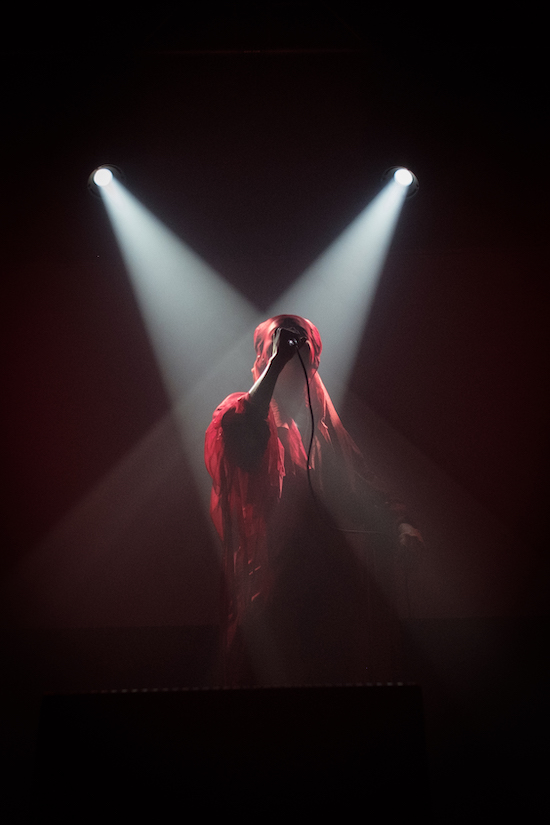
collective dreaming
"Electronics are a ladder. They’re a way to reach further than we can without them" – Laurie Spiegel, from Aura Satz documentary, Little Doorways To Paths Not Yet Taken
Watching NYX perform ‘Deep England’ with Gazelle Twin I recalled this quote. It was an exploded version of the original track, prickling and seething with barely restrained spitting, hissing and growling, all lurching in a harmonic sea sickness where organic voice and digital voice were indistinguishable. Gazelle Twin notes, "I was really excited by the use of electronics to affect all the voices in a completely different way. When we can transform, deepen, extend, loop, scatter our voices in space collectively, it’s an incredible thing."
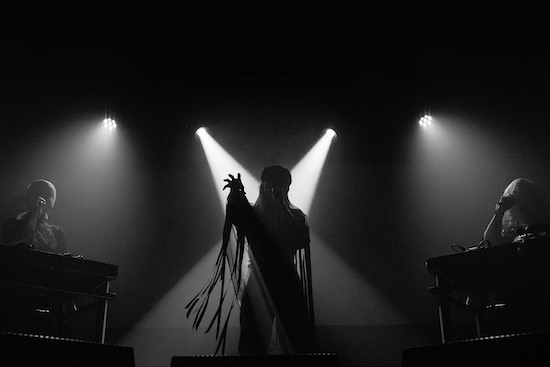
The ten different electronics set-ups have a pleasing messiness, in my "stage creeping" (nosily eyeing the equipment, normally when the artists have cleared off for dinner) there is a pleasure in the cobbled-together-ness of it all. A mix of software, vocal hardware, and a range of guitar pedals, some old, some newer. Sian is keen to emphasise the collective, its sound and use of technology as unfixed, in an emerging state. Nonetheless you can hear individual sonic fingerprints establishing themselves – Ruth’s "strobe-y bubble sounds" as she calls them, or Kelechi’s eerie use of pitch-shifting. And its something about these many, dense and colliding layers of mediation that allows the choir to not be "bound in", to find something affective that steps beyond a transparent collage of diverse techniques. As Alicia notes "when electronic manipulation comes to the forefront, it changes the way you respond to sounds."
So when I talk about dreaming, I refer to the ongoing process of reimagining the electronic choir, but also the momentary process – something akin to what Kim Cascone calls the trascendigital, a heightened state of imaginative awareness, where technology provides a portal to beyond the material.
slowness / stillness / shared intimacies
heaven and earth begin in the unnamed: name’s the mother of the ten thousand things – Lao Tze, Tao Te Ching (Ursula Le Guin translation) utilised as sung text, Iona Fortune with NYX at The Pickle Factory, 3rd February 2019
3.2.19 I watch the oddly small, glowing projection of a simple square of light behind Iona Fortune change through warm tones of yellow, orange and red. Or at least that’s what I think happened, as the shifts were imperceptibly slow. I’ve written down "stark" about the sonic experience about three times, and then "soft floating shapes across time not specific tracks."
10.3.19 Shireen is repeating a phrase from Plath’s Bell Jar over and over, "I took a deep breath and listened to the old brag of my heart. I am, I am, I am". A tremolo slices through her utterances, dragging them out, like paint pulled with a Richter squeegee.
Spaciousness here functions not only temporally but in terms of frequency and dynamic – across these axes visceral and sonic sensation are heightened by the tension between stasis and event, and in the contrast between the drawing of attention to singular elements and the climactic use of the ensemble. See the NYX rehearsal plan for Yu with Iona Fortune, taken from rehearsal 2nd Februrary 2019
Iona Flute
S and Iona duet four to five minutes
CC spoken word, second time K on bass
Iona second flute part
K bass line at eight minutes
Drones, layering and looping develop out to A solo at 11 minutes
Imogen reflected that "I felt like the director of stillness rather than the director of movement" but this capsizing of her role was exciting, "because stillness, with intention, is really potent." Alicia adds "The pieces really allow for the audience to sit within the drone and the ambient washes. We’re working with embodied sound to create an embodied experience, we’re sharing something intimate, with all the bodies together in that collective space. It’s a very powerful thing." So the bold deliberate slowness and audible fragility of the semi-improvised structures create an anticipation, the audience is actively entangled as they are party to things (and un-things) unfolding horizontally and vertically across time and space. And while its hard to explain how this functions, you do sense we’re all bound together in an extended moment of held breath.
Recent scholars have pointed to the positive potential of meaninglessness in drone or the multifaceted indeterminacy and mutability of noise. Marie Thompson has posited that both noise and the voice constitute connectivity, and I’d suggest that somewhere in the network of these collisions, between voice, noise, drone and space, an intimate relationship between performer and audience occurs. As Thompson says, "the voice has a particular capacity to evade and permeate material and symbolic boundaries; it is transitional, always in a state of in-between; existing on the threshold between inside and out, caught in the space between me and you." (from "Gossips, Sirens, HI-Fi Wives: Feminizing the Threat of Noise" in Resonances: Noise and Contemporary Music)
droning on
The continuing relationships with these collaborating artists is testament to the fun and friendship that seems to be at the heart of the collective. Contrarily, it’s the capacity for perpetual mutation that I’m most looking forward to seeing play out; the ever-so-slightly unresolved nature of the work, something momentary in a state of constant flux, as Iona observes, "having all the sirens of NYX onstage, the energy that brings, played out in one moment in time, the experiments, successes and failures."

